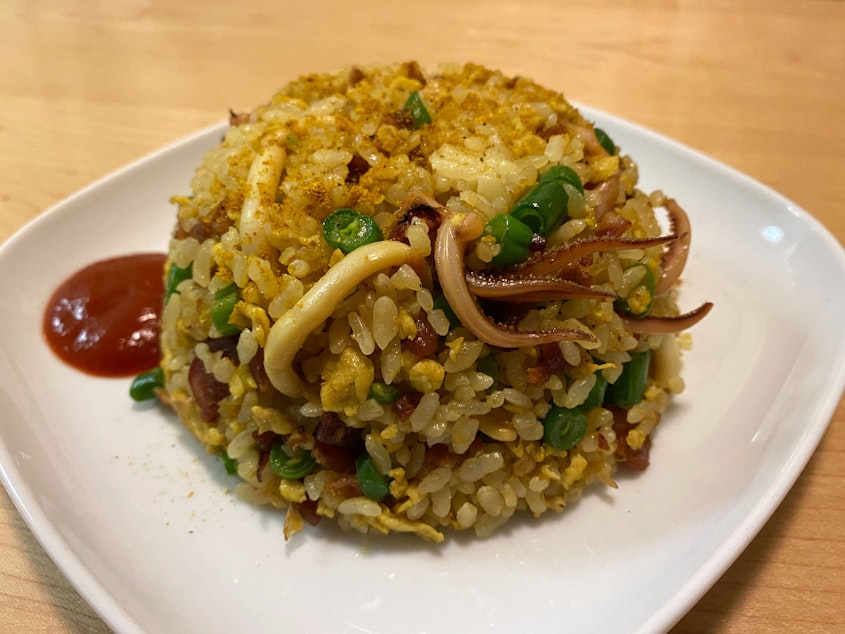Cooked too much food? Start a pandemic meal exchange

So you’ve been cooking and baking up a storm ever since the pandemic shutdown. Now what to do with all that food?
Sure, you can freeze the extra food. Or, if you’re Gracie Santos, you start a meal exchange.
Before the coronavirus outbreak, Santos worked as front of house manager for Archipelago, a restaurant in Seattle’s Hillman City. But like many businesses, it’s been temporarily closed. So Santos has found other ways to keep busy.
“I’m like, cooking a lot of different meals and a lot of it.”
And she’s having fun with it. Santos said she’s cooking a lot of Filipino dishes.
“So there’s sinigang, which is a sour soup,” she explained. “We’ve made pork adobo, chicken adobo, squid adobo, every kind of adobo you can think of basically!”
Adobo is a classic Filipino dish that involves braising meat in soy sauce and vinegar with lots of garlic. For Santos, cooking is a way to stay in touch with her mom, Gloria, who guides her over the phone.
“When she wants to cook something and she forgets what the recipe is, she calls me [on] FaceTime,” Gloria said. “And while she’s doing it and we’re talking together — how to cook it.”
But with all that cooking, eating the same food day in, day out can get old. Santos said that even with a roommate, there’s still plenty of leftovers.
So she started packing up the food to share. Some will go to her mom who had open heart surgery in February. She’s not able to go to the store during the pandemic so Santos picks up groceries.
“And when I got the stuff, I cook,” Gloria said.
Santos usually makes the deliveries curbside and from a safe distance. Whatever they cook, they pack some for Santos' friend, Jordan Lock.
“The last exchange she dropped off some carrot cake and some strawberry rhubarb pie, which is really good,” Lock said.
He added that the baked goods are especially welcome since he doesn’t bake much, not to mention the shortage of baking ingredients at the store.

Lock is an architect who’s been working from home. He also likes to cook.
“I made a bunch of different things: Some split pea soup, and I’ve made fried rice, and I’ve made tacos with ground turkey,” he said.
Lock said he and Santos have a tradition of trading leftovers the day after Thanksgiving. This meal exchange is an extension of that and it’s been rewarding.
“You get to eat a bunch of food, you can find out what your friends are really good at making, and what their experiments really failed at," he said. "It can be a good way to have fun and still be safe.”
It’s also way to stay connected. Santos wonders whether they’ll continue sharing meals after the shutdown is lifted.
“I think it would be great,” she said. “I think we should keep it going.”
Gloria can’t wait to get back to her regular routine. Before the pandemic, she would host a potluck with neighbors in her apartment building. But that will have to wait.
For now, she finds comfort from the meal exchange even though she’s not able to see her daughter face to face.
“I’m doing fine even though there’s a pandemic; there’s people who love me and care about me. And I’m doing good.”
Because cooking and sharing your food is one way of showing love.
Gracie Santos has been making a lot of adobo during the shutdown. Here's her mom’s recipe for Pork Adobo.
Ingredients:
1 lb. pork belly, cut into bite size pieces
1 lb. pork butt (pork shoulder), cut into bite size pieces
1 onion, chopped
1 head of garlic, cloves separated and crushed
1/2 cup soy sauce
1 cup vinegar
6-8 whole black peppercorn
6-8 dried bay leaves
2-3 tablespoons of cooking oil
In medium-sized pot, sauté garlic and onion for a few minutes in your cooking oil of choice. Add pork and cook for 5 minutes, lightly browning the meat. Pour in soy sauce and vinegar. Add bay leaves and whole black peppercorn.
Mix ingredients together and bring to a boil. Reduce heat and simmer for 1 to 1.5 hours, mixing sporadically and adding vinegar and soy sauce to taste. Ratio of vinegar to soy sauce should be 2:1, but I always put a LITTLE more vinegar.




